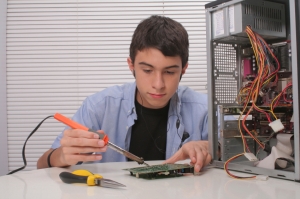
Scientists are finding that during early adolescence, around ages 12-15, the brain undergoes one of the greatest remodeling projects of any other point in the lifespan. The purpose is to prepare teens for adulthood—to stand on their own, to make decisions, to secure resources, reproduce, form partnerships, and create community. And brain restructuring isn’t the only alteration.They experience changes in all spheres: neurological, cognitive, social, psychological, and physical. Meanwhile, technology is evolving at warp speed. A biological generation is 20-30 years, but scientists estimate that a “technological generation” is only seven years. According to Moore’s law, it could be even faster: The pace of technological change may actually be doubling every two years.
How does this rapid rate of technological innovation intersect with the tectonic changes of early adolescence—and how should you respond as a parent?
1. Inform yourself about technology.
It’s helpful to stay current with technology issues that can affect your teens, both for your own reality-testing and to help “scaffold” kids’ technology use. It’s helpful if parents can sort out fact from fiction about teens’ Internet use: to stand calm in the face of media-generated “moral panics”; to learn how teens are really using social media; and to understand the battle over our teens’ attention, intention, and self-direction.
For a thorough, research-based, and balanced consciousness-raising about technology, check out Howard Rheingold’s book Net Smart: How to Thrive Online. Rheingold’s book is filled with specific and helpful insights. For example: “There is nothing more important than for kids to learn how to identify fake communication.” Websites can be “cloaked” (sponsored in hidden ways by agenda-driven organizations whose involvement is not obvious, for example the Ku Klux Klan hosting a website on Dr. Martin Luther King, Jr). Kids need to be detectives, he says, and use multiple strategies to triple-check the authority of sources. Many young people don’t understand how online content is actually generated—for example, that their Google searches are biased by algorithms generated by their previous searches, or that editing discussions on Wikipedia can be useful to discover controversial themes about a topic.
Contrary to popular belief, kids are not inherently smart about the Internet, danah boyd says in her book It’s Complicated. Scholars say that the terms “digital natives” and “digital immigrants” are inaccurate and misleading—kids are actually more naïve about technology than we want to believe, especially those from low socioeconomic backgrounds who have trouble reliably accessing and knowledgeably using the Internet. If we want our teens to be empowered by technology, we need to give them the skills to succeed, and that starts with being informed ourselves.
2. Support teens’ relationships online and off.
One of the ways nature starts to nudge young teens out of the nest is by making them interested in—in fact, super-sensitive to—their social world. Peers take on new importance around age 12-13 years old, as teens begin to individuate from their parents and seek new tribes.
Social media, then, becomes an important extension of their social lives. Far from being a time-waster, boyd says in It’s Complicated, tending relationships online not only meets their relationship needs, it helps them overcome the ever-increasing challenge of actually seeing each other in real life—thanks to overscheduling, limited mobility, greater distances between friends, and fewer public spaces for teens. By tagging friends, teasing and commenting on feeds, or uploading photos, adolescents are extending the pleasure of the offline relationships—what their parents used to do on the phone, passing notes, socializing on the bus, or loitering downtown.

Both in-depth interviews and survey research show that for the most part, teens seem to handle their online relationships pretty well. More teens report that they had an experience online that made them feel good, or feel closer to other people, than teens who did not use social media. Most teens effectively manage their reputations and their privacy online, pruning content, deleting contacts, or withholding personal information; and the majority know that sexting is off-limits. The Internet even seems to facilitate teens’ developing identities, with easy access to communities with diverse interests: A teen can find someone like themselves, somewhere, on the Internet.
But there are vulnerabilities. Younger teens, especially, can be easily dysregulated by their peers. For example, laboratory studies have shown that teens—more than children or adults—release a greater amount of the stress hormone cortisol when they’re doing a task and think someone’s watching. One study showed that teen girls get more anxious and depressed than adults when they are excluded from a game. And studies using driving simulations show that teens can be as accurate as adults when “driving” alone, but they make more mistakes and have more accidents when a peer is sitting beside them in the passenger seat.
The conventional wisdom that young teens are emotionally sensitive is true. They feel more intensely and have higher highs and lower lows. And brain scans confirm this. The limbic system in teens—the seat of emotional reactivity in the brain—shows greater activation compared to both children and adults.
Social media is visible, scalable, and permanent—that is, a comment or photo can be seen by all, forwarded infinitely to other audiences, and live on the Internet in a permanent record. For teens who have difficulty regulating their feelings—or are targeted by those who can’t—these elements in combination with developmental vulnerabilities can make for a perfect storm.
How can parents help? Adults can co-construct their teens’ online social experience in a number of ways:
Help kids navigate the various contexts of their relationships. One of the mistakes teens make online is to forget that people from different parts of their lives all see the same messages, something boyd calls “collapsed contexts.” Talk explicitly about—and model—healthy relationship skills. Empathy, perspective-taking, and conversation skills learned offline will show up in online “netiquette.”
Acknowledge that teens are starting to deal with sexual feelings—being attracted to, and being the object of attraction from, others. Stay in conversation with them to help guide them toward healthy, age-appropriate, sexual behaviors.

Encourage different kinds of relationship skills in real life. Many professionals say that young people lack face-to-face negotiation skills. How to talk and write to people of different power levels, how to resolve conflict, and how to network, are complex and nuanced skills necessary for a successful adult life. Online interactions are asynchronous (one person comments at a time often with a gap in-between), but face-to-face interactions involve reading a lot of social cues simultaneously and making intelligent decisions quickly.
Be available when teens are ready to talk about how their social lives are going. This is often late at night or in the car or doing the dishes or on the basketball court...on teens’ own timelines.
Support real-life gathering spaces. Make it clear that your teens’ friends are welcome to gather at your house (all you need is food and a little space), or be willing to drive them to friends’ homes. Look out for your teens’ friends, and make friends with their parents. Not only will your teens feel supported, but these networks will eventually come in handy.
Though most teens manage their online reputations and privacy pretty well, it’s inevitable that teens will make dumb mistakes—it’s the privilege of adolescence. In the old days, someone might repeat a bungled flirtation or a thoughtless remark to a few people, but now the Internet amplifies mistakes in ways we parents never dreamed of. Talk with your teen about hitting their emotional pause button before playing out thoughts and feelings online.
Everyone seems to look happy on Facebook. Discuss the “performative” aspect of social media—that offline lives almost always look different from how they appear online. At the best of times, young people engage in a lot of “impression management” in the hopes of fitting in and controlling their social status. On social media, it’s easy to feel excluded, or be confused by “humblebragging,” or have FOMO – the fear of missing out. “It’s almost impossible to not compare yourself to others,” says Yale psychologist Robin Stern. "It can be helpful," says Stern, "to have frequent conversations with a teen to support their hold on reality."
And finally, hang on to the courage of your values. The pressure to live online is real but ultimately optional. Social media was created not as a benevolent entity but as a profit-making business that has made a few people rich but is agnostic to kids’ development.
3. Look out for their intellectual development.
Every technological change, from the creation of the pencil to mandatory formal schooling, co-constructs young people’s cognition and intellect. That is a fact. But what, exactly, is the effect of the Internet on our teens’ intellectual development? There are no black-and-white answers to that yet—because there is just not enough research—and even expert opinion is all over the board. For example, Harvard’s Steven Pinker is cavalier, technology scholar Cathy Davidson is enthusiastic and practical, and journalist Nicholas Carr is worried.
As a parent myself, I’d be wary, depending on a child’s age. In the view of many developmental psychologists, early childhood is “smorgasbord” time—a period when exposure to lots of different kinds of activities can both reveal and create a child’s interests and strengths and vulnerabilities. Too much of anything, including screen time, becomes limiting. Real-life play is the “work of childhood”—where children explore and discover the natural laws of the world as they bang on objects, pour fluids, and drop things. Immediate back-and-forth interactions with real people—friends and siblings and parents—lay the foundation for later social skills, moral development, self-regulation, agency, and creativity. And unfettered access to their own internal rhythms--tuning in to when they need to rest, or recharging with parents, or exploring, or daydreaming--is the foundation of self-regulation.

But by the early teen years, ages 10-14, the brain is starting to specialize. Vigorous pruning of unused neurons begins and makes the brain more efficient. We see this on brain scans as the amount of gray matter, or cell bodies, declines. Because the “neurons that fire together, wire together,” whatever teens are doing or focusing on can become particularly well-established. Whether teens are vegging on the couch, playing sports or music, or building robots, early adolescence is a sensitive period for consolidating skills. If younger children are generalists, teens are starting to become specialists—getting more competent in areas they’re interested in.
At the same time, the number of connections among brain cells proliferates. We see this on brain scans by the increase in white matter, the fatty myelin sheaths that house the connecting part of the neurons. This reorganization helps thought become more abstract and integrated and logical, and makes for an especially fertile period of creativity. Teens are attracted to novelty—a desire that makes them venture out into a wider and unknown world—and their brains are looking for new synaptic connections. The Internet can be an important resource in the creation and reorganization of teens’ intellect and creativity. Indeed there is some evidence already that it can enhance creativity in music and graphic arts.
But some worry that heavy Internet use in general can render teens more intellectually superficial and inaccurate as they quickly shift their attention from topic to topic. Stanford scholar Cliff Nass, who lived in a freshman dorm alongside students, observed that freshman who were heavier online multitaskers wrote English essays that were simpler and more disconnected than other students. Nass’ now-famous studies on multitasking show that though a small number of people can multitask well, for most, multitasking carries a high mental cost. In general, heavy multitaskers get less done and show a greater degradation of performance. Many highly regarded scientists say technology is “rewiring our brains” in a detrimental way—that our brains are not evolved for the “nonstop interactivity” and that multitasking, in particular, has “lingering cognitive effects.”
And yet others, like Pinker, say that the Internet makes us smarter, offering unprecedented access to tools and content and people. Cathy Davidson says in her book, Now You See It, that multi-tasking might be beneficial and may create rich, new, cognitive maps of a higher order that just reflect new ways of thinking. She points out that expert online teen gamers are thought to make outstanding future political and business leaders because they master large, diverse systems, deal with constant novelty, and stay steady in the face of change, in order to win. And even Rheingold is careful to acknowledge that we shouldn’t preemptively make dire predictions about long-term effects of new technology based on old ways of thinking.
Having studied and taught about children’s cognitive development for years, my own bias is this:
It is our job as parents to help children discover their potential, to support their emerging strengths, and to help them shore up their vulnerabilities. Many kinds of cognition are both important and useful in personal and work lives—reflection, analysis, creativity, spaciousness, quiet, speed, integration, etc.
Teens’ unique strengths and interests become more clear, especially in the mid- to late-teens, and it is helpful to support and reinforce these emerging talents. At the same time, unless they’re unusually focused and their future careers are already clear (which is rare), exposure to a breadth of cognitive abilities fosters flexibility for many kinds of work and interests. That said, you have to work with your own unique teen, and fostering breadth may not always work. When I encouraged my very active 13-year old to take a meditation class to learn to focus and relax, it backfired. It wasn’t for her, and she may never focus on her breath again. But she’s in engineering school now, reasonably adjusted, and doing fine.
4. Foster and protect your teen’s developing personal empowerment.

The early teenage years are a sensitive period for the emergence of personal power. This is when teens begin to individuate, unhooking their identity from their parents and beginning the journey to find their own identity. They know who they’re not (their parents), but they don’t yet know who they are.
Enter into this fragile sprouting of their identity, the manipulations and pressures of the outside world. Many scholars have written about the vulnerability of this period—how girls’ voices can go underground, or how boys can be hassled out of close, same-sex friendships, leading to depression and anxiety. Educators and business leaders see our teens mainly as future workers. Corporations go after them as potential consumers. There are many forces that wrangle with us over our children’s developmental arc and the Internet has widened the pipe through which the outside world enters our children’s lives.

Advertising is particularly insidious and today’s teens are growing up in a uniquely, commercially saturated environment. Advertisers spend millions of dollars a year exploiting the science of attention to get viewers to tune into or out of whatever they want. A Pew survey found that teens are regularly advertised to, including content that 30% of teens say is “inappropriate for their age.” Advertising now reaches its tentacles into “integrated platforms”—see here for a description of how advertisers use “immersive websites, advergaming, viral marketing, mobile ads, social media marketing and precise behavioral and location targeting” to blur lines of ads, content, entertainment, and social media.
Happily, many teens are wise to these forces. In a recent talk at UC Berkeley, boyd described how the teens she talked to delighted in small acts of resistance, messing with advertisers’ algorithms or sending messages that make diaper ads show up on their friends’ feeds—a special kind of teen humor.
Perhaps more than ever, it’s important for teens to develop an “internal locus of control”—the knowledge and skills to control their own actions in the world. At a personal level, teens learn to take themselves seriously when parents engage respectfully with teens’ feelings and perceptions. But it’s also helpful to have an ongoing conversation that is critical of the media-saturated world in which we live, much as we once did about the effects of television. Making the invisible forces apparent takes away some of the power over us. “Today’s digital literacies,” says Rheingold in his introduction to Net Smart, “can make the difference between being empowered or manipulated, serene or frenetic.”
5. Foster self-awareness.

Knowledge helps, but so does self-awareness.
The prefrontal cortex—the part of the brain that can observe itself, is the self-regulator, the executor that makes decisions about thoughts and feelings—is present from birth but develops significantly in adolescence and doesn’t finish consolidating until around age 25. Because this self-awareness is just emerging, it is hard for teens to step outside of themselves to evaluate what’s happening to them.
Technology expert Linda Stone says that attention is one of the most powerful tools of the human spirit—and she says we can magnify it with meditation and exercise, or we can deplete it with hyperconnectivity. She noticed that when people are online, checking e-mail, surfing websites, and scanning for information, they don’t really switch between screens with the whole of their attention (as multitasking implies), but they engage in a continuous partial attention—paying a little bit of attention all of the time. This state exacts a cost, she says: Breathing becomes slower and more shallow and the mind stays hyper-alert—something the body experiences as a constant demi-crisis. In small doses, this can be functional, but in large doses can make us feel overwhelmed, overstimulated, and “ultimately powerless.”
There is more competition now than ever before for teens’ attention. Teens who want to be in control of their lives will increasingly need to monitor how they focus and manage—or give away—their precious attention. Parents can support younger teens by helping them to set up realistic goals for a task; create short, manageable timelines together; and agree on how to screen out peripheral information. Check in periodically to see how teens are doing. This practice will help them to develop the muscles to stay in control of their own attention and make conscious decisions—under their own direction—about when to deviate from their own goals. Emerging research in other areas suggests that self-awareness and self-management can be cultivated earlier than we thought if taught in age-appropriate, supported ways.
It’s also helpful for teens to check in with themselves periodically about their emotions. Is hanging out on social media making them feel connected and happy, or sad and excluded, or inferior? Pausing to acknowledge how they feel can allow them a choice to either maintain the feeling or do something to change it.
Because different brain systems come online at different ages, there is an imbalance in teens’ emotionality and their ability to manage those feelings. Their resistance to peers’ influence gets better over the teen years, but it’s particularly challenging at 12-14. One in five teens regret something they post on social media. It’s helpful, then, for teens to practice taking a “meta-moment”—a pause between being triggered and responding—in order to choose a path with the outcomes they really desire.
Teens are also in the process of learning to manage their time. Their cognitive understanding of a sense of time gradually improves, but their ability to plan ahead and connect actions with consequences actually takes a dip around 12-14. If-then thinking can also be elusive, e.g.,“If I play online games now will I have time for my homework?” So teens can definitely benefit from a time structure gently imposed by parents, and help processing future-oriented decisions, until they get better at it themselves.
6. Prioritize offline connections—they’re still the most important
Contrary to popular belief, teens say they prefer face-to-face interactions rather than online ones. Teens rely on their secure human relationships to anchor and guide them, from infancy through adulthood. In fact, scholars call relationships with people who care, “developmental delivery vehicles,” for all the goodness—validation, information, structure, safety, love, and warmth—packed into them. (For a beautiful discussion of how in-person relationships affect us differently than online relationships, see Barbara Fredrickson’s article here on the physiology of offline connections.)
Both teens and adults express concern that family members spend too much time online at the expense of in-person connections. As a parent, of course, you should practice what you preach—kids want you to turn off your devices and tune in to them. Make no mistake: Even though teens are trying to become autonomous, they, too, still want to maintain close connections and have conversations with their parents about things that really matter. They have been telling researchers so for decades.
7. Watch out for when things go wrong
There’s a lot to be dysregulated by in the early teen years—heightened emotionality, salience of peers, incomplete self-management skills, poor judgment of time. To add fuel to the fire, the surges of dopamine that teens get are much greater than in either childhood or adulthood—so everything is just that more exciting and rewarding. This makes risk-taking more likely (nature’s design so that teens will happily venture out into the world) and addictions more possible. A 2009 study showed that one in ten youth gamers are pathologically addicted. Though most teens (71% surveyed) know that sexting is wrong, some have actually been charged with sexual offenses since they are in possession of explicit photos of a minor. (Professionals argue that sexting reflects a growing interest in sex—and a naïveté about technology—rather than a criminal intent, and should be treated as such.)
If you’re lucky, your teen will bring his/her problems to you. Yale psychologist Robin Stern suggests that at those times, respond first with empathy or a hug, while you check in with yourself to manage your own triggers, anxiety, and beliefs. Then, make space for your teen to just express his or her feelings and concerns with gentle prompts and encouragement. And finally, explore problem-solving together.
On the other hand, sometimes parents notice changes in their teen that signal problems that aren’t being spoken about, says Stern. In that case, she recommends that parents first think about the goals of the conversation they want to have. Then watch for a good time to talk. Begin gently: “I noticed that you looked sad when you got offline….” More conversations starters can be found here and here. And then continue as above.
How can you tell if your teen is struggling? Pay attention. Lots of teens “cry out” on the Internet, and boyd notes that if a teen does something dramatic online, it’s likely that she is having a hard time offline and needs loving care. Stern says that any significant changes in behavior can signal that something’s up: less appetite, more appetite; sudden changes in friends or suddenly no invitations from friends; withdrawal or hyperactivity; an inability to function in normal life.
If you haven’t had an obvious signal that anything’s wrong but are still wondering if your teen is doing okay, I recommend reviewing four areas of your teen’s life:
Is their sense of self reasonably intact? Do they seem to have good self-esteem? Can they express themselves and mostly get their needs met appropriately for their age?
Are their relationships intact? Kids vary enormously in the number of friends they enjoy, but everyone should have at least one friend. Can they talk to adults? Do they have other appropriate relationships they enjoy?
Are they doing reasonably well cognitively/intellectually for their age? Do they have interests, pursuits, hobbies?
Is there an absence of notable pathology?
If these areas seem okay, your teen is probably doing just fine.
There is no one-size-fits-all approach to helping your unique teen manage technology, but understanding their development can help inform your decisions. Beyond that, enjoy your teen and continue to connect in ways that you both enjoy—that’s the glue in your relationship, the sunshine to their flower, and the guiding star that will get you through the rough spots.
